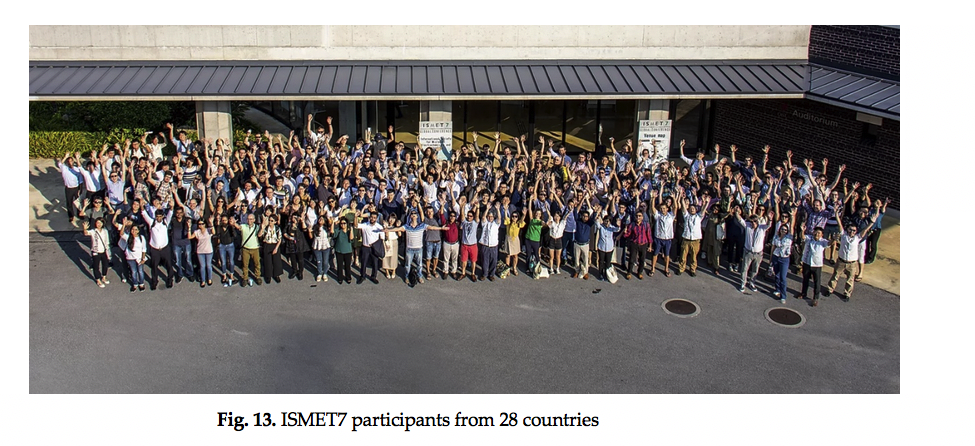FY2019 Annual Report
Biological Systems Unit
Professor Igor Goryanin
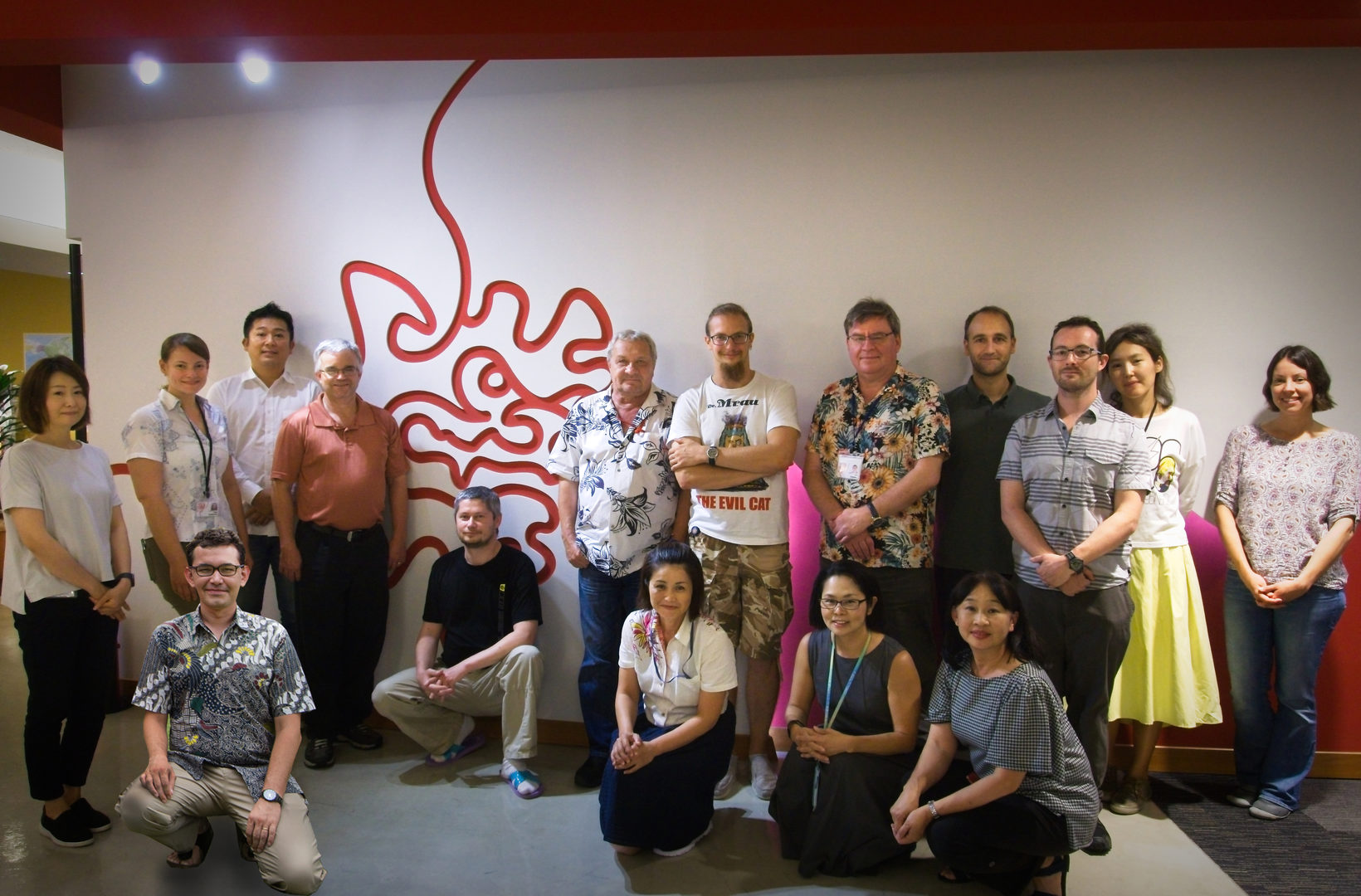
Abstract
For last years, the Biological Systems Unit has been engaged in development of BioElectrochemical System (BES)/Microbial Fuel Cell (MFC) technology for wastewater treatment. The BES/MFC applies complex interactions between microbial populations and electrodes to remove organics and to generate electricity, merging basic and applied goals of our Unit. By utilizing biological, chemical, engineering, and bioinformatics approaches, the Unit seeks to improve BES/MFC systems for better treatment efficiencies and electricity generation by understanding and building ideal microbial communities and developing cost-effective materials. Sustainable wastewater treatment is especially important for small islands like Okinawa.
One of the challenges of this technology is scaling up. The Unit has been working with a local Awamori (Okinawa unique spirit) distillery for the past seven years to treat rice wash and distillery wastewater and the world largest scaled-up reactor was constructed using our patented proprietary ion exchange membranes and catalysts. The project was funded by Japan Science and Technology Agency (JST) and developed into establishment of spin-off company “BioAlchemy”. The unit continuously received two grants from Okinawa Prefecture Government to develop technologies to 1) remove nitrogen and phosphate from swine wastewater using BES systems to meet the discharge level and 2) develop methods for bioremediation to clean anaerobically diesel-contaminated groundwater. The MFC/BES system was also utilized to remove organic acids to allow recycling of bioethanol process water (thin stillage water) in collaboration with COFCO, China. The development of a software called Advanced metagenomic Sequence Analysis in R (ASAR) allowed simultaneous analysis and visualization of taxonomy and metabolic pathways from metagenome data to understand and improve complex microbial communities. Our international collaboration extended with the U.S., Russia, the U.K., Thailand and Hungary. Another highlight was that the Unit organized 7th International Society for Microbial Electrochemical Technology Conference (ISMET7) at OIST which is the largest international conference in the BES field.
1. Staff
- Dr Igor Goryanin, Professor
- Dr. Mami Kainuma, Group Leader
- Dr. Slava Fedorovich, Staff Scientist
- Dr. Peter Babiak, Staff Scientist
- Dr. Lukasz Szydlowski, Postdoctoral Fellow
- Dr. Anna Prokhorova, Postdoctoral Fellow
- Mr. David Simpson, Technical Staff
- Mr. Tomoharu Inoue, Technical Staff
- Dr Marsel Murzabaev, Technical Staff
- Mr. Geoffrey Schaffer-Harris, Technical Staff
- Ms. Susan Boerner, Technical Staff
- Dr. Marina Khandarkhaeva, Research Assistant
- Ms. Rie Hiyane, Research Assistant
- Mr. Pablo Irisarri Aguilar, Research Assistant
- Ms. Noriko Shibata, Research Assistant
- Ms. Shizuka Kuda, Research Unit Administrator
2. Collaborations
2.1 A microbial fuel cell-based system for winery wastewater reuse (USA)
- Type of collaboration: Joint research
- Researchers:
- Professor Michael F. Cohen, Sonoma State University, USA
- Professor Farid Farahmand, Sonoma State University, USA
2.2 Treatment and electricity generation of pineapple processing wastewater using microbial fuel cells (MFCs) (Thailand)
- Type of collaboration: Joint research
- Researchers:
- Dr. P. Panichnumsin, King Mongkut’ University of Technology Thonburi, Thailand.
- Dr. C. Waewsak, King Mongkut’ University of Technology Thonburi, Thailand.
- Dr. S. Kalappanulak, King Mongkut’ University of Technology Thonburi, Thailand.
- Dr. T. Saithong, King Mongkut’ University of Technology Thonburi, Thailand.
2.3 Performance of Pilot-Scale Plug Flow Microbial Fuel Cell for Sustainable Wastewater Treatment and Energy Recovery (UK)
- Type of collaboration: Joint research
- Researchers:
- Ourania Dimou Heriot Watt University, Edinburgh, UK.
- Prof Alan Harper, Heriot Watt University, Edinburgh, UK
2.3 Microbial Fuel Cells recycling of ethanol fermentation wastewater
- Type of collaboration: Joint research
- Researchers:
- Dr. Bo Chen, Assistant Director of Biotechnology Center, COFCO Nutrition and Health Research Institute Co. Ltd, Bejing, China
2.4 Development of Microbial Fuel Cell-based technologies for wastewater treatment and characterization
- Type of collaboration: Joint research
- Researchers:
- Dr. Gábor Márk Tardy, Budapest University of Technology and Economics, Hungary
- Dr. Miklós Gyalai-Korpos, BES Europe Ltd. / PANNON Pro Innovations Ltd.
2.5 Biology of Microbial Fuel Cells and development of a software, Advanced metagenomic Sequence Analysis in R (ASAR)
- Type of collaboration: Joint research
- Researchers:
- Professor Anatoly Sorokin, Institute of Biophysics, RAS, Puschchino, Russia
3. Activities and Findings
3.1 Bioelectrochemical Systems (BES): Material development, applications, scaling up and microbial metagenomic
The following projects are dedicated to improving our BES technology, including development of cost-effective bioreactor materials, widening possible applications of our technology, including scaling up and understanding microbial communities.
3.1.1. Anion exchange hydrogels for wastewater treatment (Proof of concept program phase 2)
The project focused on commercialization of membrane technology developed in Goryanin unit. Scale up of in-house developed membrane was optimized. Production time was decreased by optimization of polymerization reaction and usage of chemical was optimized by reusing solution. Different membrane carrier materials like porous ceramic and porous plastic (PP, PE) were successfully tested. 3D printed porous carrier materials are tested now. There is huge advantage in price and shape variability in 3D printed porous materials. All these improvements increase chance for commercial success of project
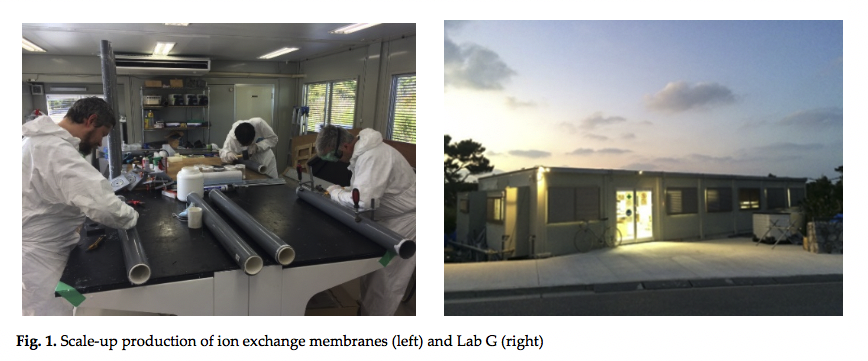
More than 20m2 of membranes on various support materials were produced to support OPG swine waste project (Phosphorus removal and recovery and nitrate removal from swine wastewater) and many other wastewater treatment projects.
The unit holds a prefabricated building (Lab G) designated for scale-up reactor production and scene of 1m tubular cation exchange membrane production in Lab G.

The project was funded by Proof of Concept (OIST).
3.1.2. Phosphorus removal and recovery from swine wastewater using in-house anion exchange membrane
The farming industry generates large amounts of wastewater that must be treated under special conditions to meet discharge regulations. As a result, many farms today are searching for cheap ways to effectively and sustainably treat wastewater. We successfully tested our electrodialysis cell with anion exchange membrane from POC project for phosphate removal from swine wastewater collected from Okinawa Livestock Research Center. Concentration of phosphate in wastewater was decreased down to discharge limit (25 mg of P/L). Lowest phosphorus concentration reached after electrodialysis in wastewater was1 mg of P/L. Next planed step is field test at the Livestock Research Center to prove technology in the real usage.
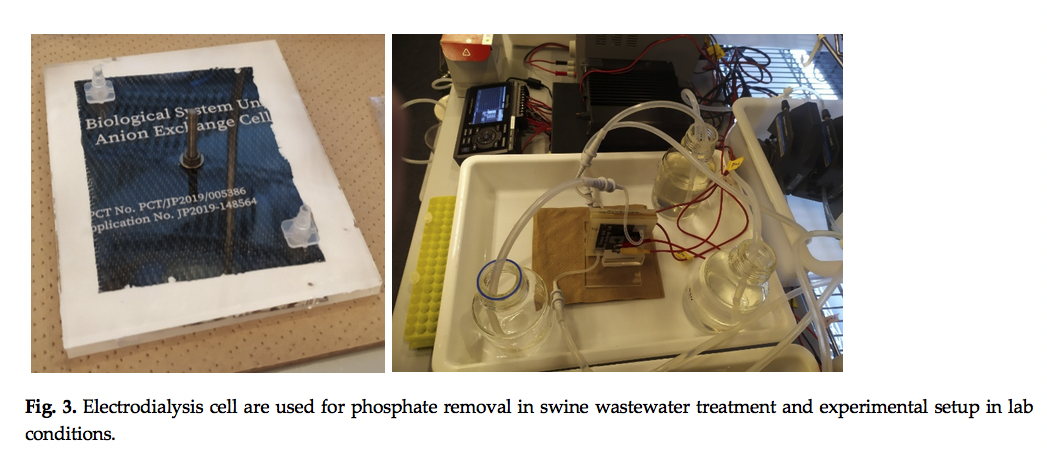
The project was funded by Proof of Concept (OIST) and Okinawa Prefectural Government.
3.1.3. R&D on swine wastewater treatment technology for simultaneous removal of nitrate and organics using bioelectrochemical systems (BES)
The volume of wastewater produced by intensive pig farming in Okinawa surpasses the available capacity for treatment and recycling. Removal of nitrate from wastewater is a worldwide concern due to its negative effects on human and environmental health. Currently the nitrate-nitrogen discharge limit for livestock wastewater receives special measure (500 mg/L) but very near future it will be lower to the general discharge standard (100 mg/L) to meet all other industries. Cost-effective nitrate-nitrogen removal in livestock industry is the urgent issue in Japan.
Continued from FY2018, the project extended to design and construct pilot-scale biocathode reactors and deployed at Okinawa Livestock Research Center. The system simultaneously treated organics and nitrate in real swine wastewater. The full-strength raw wastewater contains high organic and volatile fatty acids (responsible for malodor) that were oxidized by the microbial community in the anode chamber which supported lowering the aeration time and removing smells. Under applied potential to cathode, electrons were transferred to the cathode where nitrate from aeration-treated wastewater (nitrified) served as an electron acceptor and converted to dinitrogen by denitrification via the cathodic microbial community. Denitrification is anaerobic reaction and the advantage of this system is allowing the denitrification of low-COD/N wastewater. Microbial communities were also analyzed on the electrodes. The long-term monitoring of the pilot-scale reactors will allow us to step forward to develop devices for commercialization.
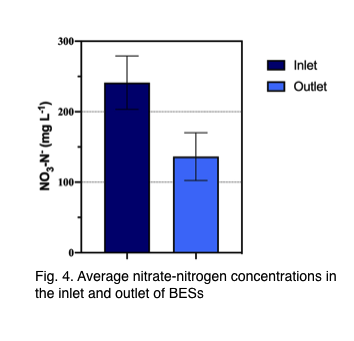
The project is funded by Okinawa Prefectural Government and conducted with a research body with Okinawa Environment Science Center, Okidoyaku and Okinawa Prefectural Livestock Research Center.
3.1.4. R&D of Anaerobic Bioremediation Technology of Oil Contaminated Groundwater
We aim to establish in situ anaerobic bioremediation technologies, including bioelectrochemical systems, to treat diesel contaminated soil/groundwater using Okinawa specific soil types, Shimajiri Maji (cray and water permeable) and Jagal (cray and water impermeable). Oil-degrading microbial communities were enriched at the demonstration site was used as inoculum to run groundwater diesel bioremediation with 5-L air-cathode microbial fuel cell reactors using proprietary electrode/membrane materials. Anaerobic bioremediation is a slow process and in the absence of oxygen such as in groundwater, the anode electrodes serves as electron acceptor for the diesel-degrading bacteria having extracellular electron transfer system.
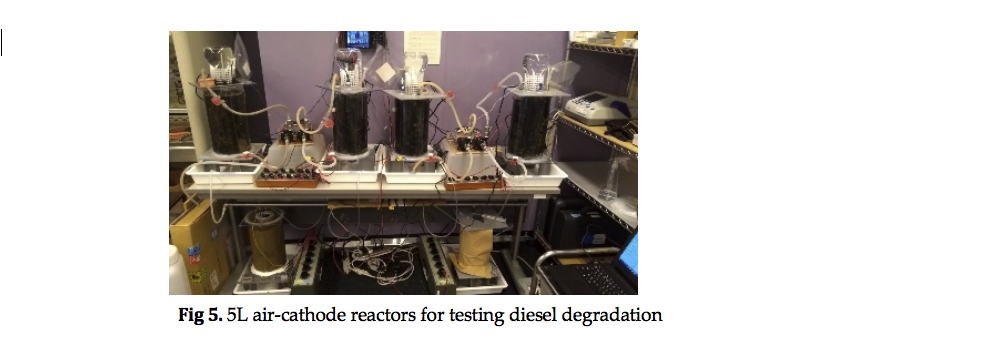
We participated in the project “Research and development of bioremediation technologies for heavy oil polluted soil and groundwater by prefectural microorganisms” funded by Okinawa Prefectural Government and conducted by a consortium of Okinawa Environmental Science Center and National Institute of Technology, Okinawa College.
3.1.5. Evolutionary dynamics of microbial communities in bioelectrochemical systems
Bio-electrochemical systems can generate electricity by virtue of mature microbial consortia that gradually and spontaneously optimize performance. To evaluate selective enrichment of these electrogenic microbial communities, five, 3-electrode reactors were inoculated with microbes derived from rice wash wastewater and incubated under a range of applied potentials. Reactors were sampled over a 12-week period and DNA extracted from anodic, cathodic, and planktonic bacterial communities was interrogated using a custom-made bioinformatics pipeline that combined 16S and metagenomic samples to monitor temporal changes in community composition. Some genera that constituted a minor proportion of the initial inoculum dominated within weeks following inoculation and correlated with applied potential. For instance, on the anode, the abundance of Geobacter increased from 423-fold to 766-fold between -350 mV and -50 mV, respectively (Fig. 1a & 1c). On the M1 and M2 cathodes, the most abundant organisms were methanogenic archaea (Fig. 2a-b); however, a proportion of Methanosaeta, the most abundant methanogenic genus from the initial inoculum, decreased during the course of the experiment with the subsequent growth of Methanobacter spp. Full metagenomic profiles of bacterial communities were obtained from reactors operating for 12 weeks. Functional analyses of metagenomes revealed metabolic changes between different species of the dominant genus, Geobacter, suggesting that optimal nutrient utilization at the lowest electrode potential is achieved via genome rearrangements and a strong inter-strain selection, as well as adjustment of the characteristic syntrophic relationships.

To analyze the diversity of metagenomes, we used multidimensional scaling (Principal Coordinates Analysis, PCoA) to look at how the communities clustered based on sample type (initial sludge, anode, cathode, plankton and OCP) at both the genus level (Fig. 3a) and functional levels (Fig. 3b) after 12 weeks. Significant differences were found for both levels, with 72% of the distance variability due to sample-type and applied potential at the genus level (Fig. 3a, p-value 0.01), and 65% (Fig. 3b, p-value 0.04) at the functional level. We can thus observe that similar communities formed on different parts of the reactor (anodes, cathodes, plankton), cluster to each other and are all being quite different from the initial inoculum. OCP control (both anode and plankton) also diverge from the initial community.
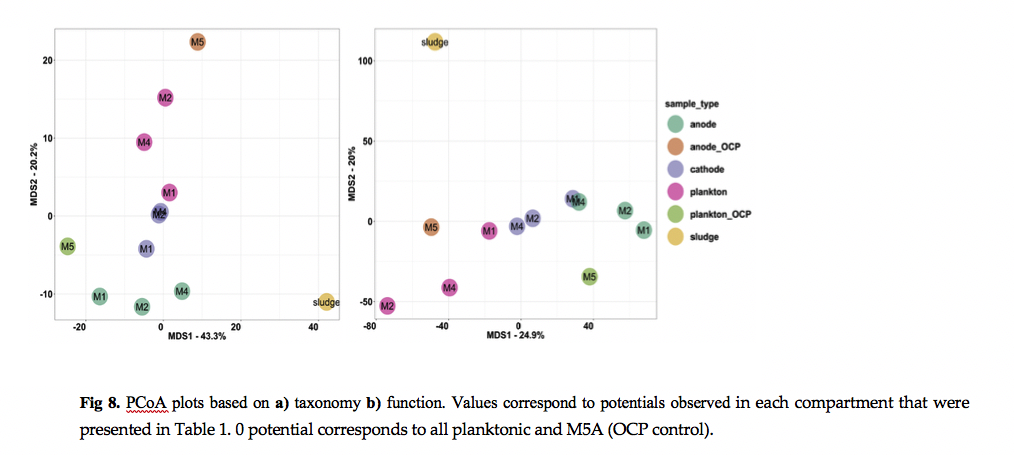
These results reveal a certain degree of metabolic plasticity of electrochemically active bacteria and their communities in adaptation to adverse anodic and cathodic environments, and this study presents the dynamic nature and complexity of microbial communities within MFC reactors.
Evolutionary dynamics of microbial communities in bioelectrochemical systems.
Lukasz Szydlowski, Anatoly Sorokin, Olga Vasieva, Susan Boerner, Veyacheslav Fedorovich, Igor Goryanin. bioRxiv 725580; doi: https://doi.org/10.1101/725580
3.1.6. Spin-off company “BioAlchemy” established
The company develops a completely new type of wastewater treatment technology that utilizes "power generating microorganisms". A technology with low running cost that not only removes organic matter from wastewater but also recovers electrical energy, and is oxygen-free and does not generate sludge easily. This wastewater treatment system is environmentally friendly, reduces the burden on companies and contributes to sustainable development goals (SDGs). In addition, it is possible to separate ammonia and phosphoric acid with electric ions, and extract new resources from wastewater such as resource extraction from wastewater that is difficult to process such as pig farming, cow dung, and soil pollution, hydrogen generation, and extraction of rare metals. Established in May 2019. We are grateful to Japan Science Technology Agency for the funding of START project
More details:
- https://www.oist.jp/news-center/news/2019/10/7/bioalchemy-treating-wastewater-point-production
- http://www.bioalchemy.jp/
3.1.7. Operation of a microbial fuel cell-based system for onsite treatment of winery wastewater
Collaborators: Professor Michael F. Cohen, Sonoma State University, and D’ Argenzio Winery at Santa Rosa, CA USA.
On average wineries generate six liters of wastewater for every liter of wine produced. Owing to space limitations, many smaller wineries are faced with the expense of trucking their wastewaters to off-site treatment facilities. Since April 2016 our collaborators in the laboratory of Prof. Michael Cohen at Sonoma State University, California, USA, have continuously operated an MFC-based system for onsite treatment of winery wastewater (WW) for use in irrigation at D’Argenzio Winery (Santa Rosa, CA).
In our system, WW from a 900-L pH neutralization source tank is pumped into two air-cathode tubular MFCs made of a 50-L custom acrylic cylinder housing with internal baffles to prevent short-circuiting of the flow. Four carbon brush anodes extend horizontally across the entire cylinder. A hollow chamber through the center of the entire cylinder bears the four cathodes having a proton permeable membrane and carbon granules impregnated with iron phthalocyanine to catalyze O2 reduction to water. Effluent from one MFC flows to an earthworm-containing vermifilter from which the outflow irrigates the landscaping. A second MFC that is in parallel with the other returns its effluent to the source tank to conserve alkalinity and microbes within the system (Fig. 9).
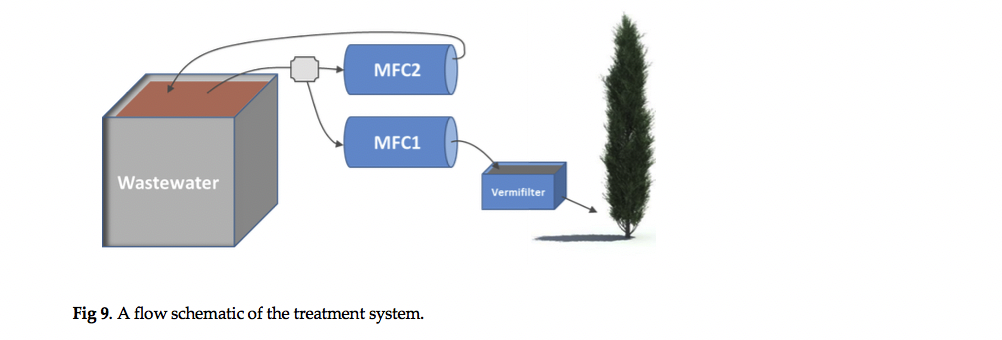
Organics removal, biogas production, and electricity generation have been continuously monitored through wide variations in seasonal ambient temperatures and changes in the strength of the WW feed. We found that the MFCs consistently removed the majority of organics in the WW and the vermifilter was effective at removing the colored polyphenolic compounds that are largely untouched by the MFCs (Fig. 10). Biogas production accounted for the majority of the energy in the organics removed from the WW while electricity generation was minimal, remaining near 35 mW m-3 for the duration of the experimental period. As the system has matured, chemical pH adjustment has become almost unnecessary, which is saving running cost. Results gathered from the testing and optimization of this system will inform the development of full-scale MFC/vermifilter-based systems to treat agro-industrial wastewaters.

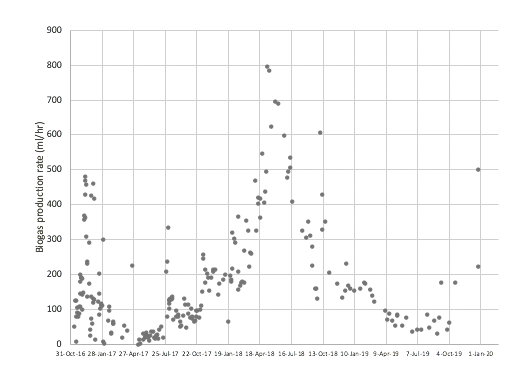
3.2. Databases, software and computational methods for systems biology
3.2.1. Software development for metagenome of bioelectrical systems
Collaborators: Professor Anatoly Sorokin, Institute of Biophysics, RAS, Russia. Dr Olga Vasieva, Ingenet Ltd., UK
Functional and taxonomic metagenomic analyses are critical steps in understanding interspecific interactions within microbial communities. Together with our collaborators we have developed a software package followed by manual curation to perform these analyses simultaneously. We have developed the ASAR DB Database, the interactive tool and databases for storage and exploratory analysis of unlimited metagenomic sequencing data along 3 dimensions: taxonomy, function, and environmental conditions, which can handle an unlimited amount of sequence information (Orakov et al. 2018a). The database is available to OIST researchers.
Database structure
In 2019 the database part of ASARdb was completely rewritten to speed up the upload process and reduce the database footprint (see diagram). Surrogate keys were introduced instead of MD5 strings, which decreases footprint by 30% and increase the speed of search queries.
Materialized views were created to store complex joins for bulk downloads during export datasets for ASAR visualization.
Dataset preprocessing and data loading
Dataset preprocessing was reorganised in a way suitable for active use of High- performance computing. New strategy separates data preparation stage, which is time- and memory-consuming, and actual data loading, which utilise MonetDB native loading facility. Data preparation could be ran on HPC cluster independently for each metagenome.
Deployment and user support
Docker image was created for ASAR/ASARdb application, which allow easy deployment of application. However ASARdb Docker image requires access to external MonetDB instance as size of the database make it impractical to incorporate whole database within image.
Code up-to-date and clearance
New version of R and R/Bioconductor required minor modifications to the ASAR code due to changes of API and retirement of libraries like MonetDBLite.
Database content
Manual curation of MG-RAST free-form textual taxonomy output was carried out. 99% of MG-RAST taxonomy terms were mapped to NCBI Taxonomy ID. For some taxons there were more than 40 various names. At the moment more than 50K taxon names are resolved.
4. Publications
4.1 Journals
1. Vasieva, O., Goryanin, I., (2019) Is there a Function for a Sex Pheromone Precursor? A Predicted Link between Bacterial Redox Metabolism and Propagation of Antibiotic Resistance., Journal of Integrative Bioinformatics., Volume 16: Issue 4., doi: 10.1515/jib-2019-0016 2. Vasieva, O., Goryanin, I., (2019) Is there a Function for a Sex Pheromone Precursor? Journal of Integrative Bioinformatics., 20190016 doi: 10.1515/jib-2019-0016
3. Lorant, B., Gyalai-Korpos, M., Goryanin, I., Tardy, Gabor M., (2019) Single chamber air–cathode microbial fuel cells as biosensors for determination of biodegradable organics., Biotechnology Letters., Volume 41: Issue 4-5, pp 555-563
4. Vasieva, O., Sorokin, A., Szydlowski, L., Goryanin I., (2019) Do Microbial Fuel Cells have Antipathogenic Properties? Journal of Computer Science & Systems Biology., vol 12., no 3., pp 57-70
5. Vasieva, O., Sorokin, A., Murzabaev, M., Babiak, P., Goryanin I., (2019) A Study on the Analysis of Personal Gut Microbiomes., Journal of Computer Science & System Biology., vol 12., pp 71-79
6. Szydlowski, L., Sorokin, A., Vasieva, O., Boerner, S., Fedorovich, V., Goryanin I., (2019) Evolutionary dynamics of microbial communities in bioelectrochemical systems., vioRxiv, pp 725580
7. Khandarkhaeva, M., Batoeva, A., Sizykh, M., Aseev, D., Garkusheva, N., Photo-Fenton-like Degradation of Bisphenol A by Persulfate and Solar Irradiation., Journal of Environmental Management, vol 249, (2019) pp 109348
4.2 Books and other one-time publications
Nothing to report
4.3 Oral and Poster Presentations
- Prokhorova, A., Bacterial community involved in the biocathodic denitrification of swine wastewater in bioelectrochemical systems., Water and Environment Technology Conference 2019 (WET2019)
- Prokhorova, A., Enhanced scalable bioelectrochemical system for the biocathode denitrification using swine water, 7th International Society for Microbial Electrochemistry and Technology Conference (ISMET7) (2019)
- Szydlowski, L. High-throughput screening and selection of electrogenic microbial communities using single chamber microbial fuel cells base on 96-well plate array 7th International Society for Microbial Electrochemistry and Technology Conference (ISMET7) (2019)
- Babiak, P., Schaffer-Harris, G., Fedorovich, V., Goryanin, I., Development of hydrogel-based anion exchange membrane-AEM, 7th International Society for Microbial Electrochemistry and Technology Conference (ISMET7) (2019)
- Murzabaev, M., Kainuma, M., Babiak, P., Furuie, K., Tanabe, T., Goryanin, I., Microbial Community Shift during Oil Contamination in Okinawa Soils. Water and Environment Technology Conference 2019 (WET2019)
- Murzabaev, M., Kainuma, M., Furuie, K., Tanabe, T., Yamaniha, Y., Goryanin I., Development of bioelectrochemical system for soil/groundwater of remediation. 7th International Society for Microbial Electrochemistry and Technology Conference (ISMET7) (2019)
- Kainuma, M., Sacher, G., Ramirez, I., Simpson, D., Goryanin, I. and Cohen, M. On-site winery wastewater treatment using bioelectrochemical systems. 7th International Society for Microbial Electrochemistry and Technology Conference (ISMET7) (2019)
- Simpson, D., Long-term operation of a pilot scale Bio-Electrochemical System treating awamori distillery wastewater Okinawa, 7th International Society for Microbial Electrochemistry and Technology Conference (ISMET7) (2019)
- Borner, S., Babiak, P., Murzabaev, M., Sorokin, A., Vaseiva, O., Goryanin, I., Computational Analysis of Microbiomes., A World of Microbiota Conference (2019)
- Prokhorova, A., Kainuma, M., Hiyane, R., Vasieva, O., Kazeoka, M., Suzuki, N., Ninomiya., Goryanin, I., Swine wastewater treatment technology for simultaneous removal of nitrate and organics using bioelectrochemical systems (BES) The 5th Fatty Pig Conference (2019)
- Babiak, P., Schaffer-Harris, G., Kainuma, M., Goryanin, I., Economic potential of phosphate recovery in swine wastewater treatment., The 5th Fatty Pig Conference (2019)
4.4 Others
Outreach
1. Event: OIST Forum 2019. Simpson, D. Mar 5, 2019. Kanda Myojin Hall, Tokyo
Program description: “Deep Tech” evolves the World - disruptive innovations based on cutting edge research results that require longer time scales to grow. Paying audience of venture fund managers, industry, academia and government. 15-minute pitch. (around 200 people participated)
2. Event: JST New Technology Showcase. Simpson, D. Jan 22, 2019. OIST
Program description: “Bioelectrochemical systems for the purpose of wastewater treatment” 30-minute presentation to the general public, academics and industry representatives followed by name-card exchange and 4 private interviews (around 100 people participated)
5. Intellectual Property Rights and Other Specific Achievements
1. Fedorovich, V., Filonenko, G., Goryanin, I., Schaffer-Harris, KG., Simpson, DJW and Babiak, P., Separator of a microbial fuel cell, W2919160046A1
2. Babiak, P., Schaffer-Harris, KG., Kainuma, M. and Goryanin, I. Method for treating wastewater and wastewater treatment system JP2019-148564
6. Meetings and Events
6.1 7th International Society for Microbial Electrochemistry and Technology Global Conference (ISMET7) October 7-12, 2019
The highlight of the unit in 2019 was the organization of the largest international conference in the field of Bioelectrochemical Technology at OIST (7th International Society for Microbial Electrochemistry and Technology Global Conference (ISMET7)).
https://www.ismet7.com/program
230 researchers over 28 countries gathered at OIST and discussed the relevant topics including fundamentals of extracellular electron transfer, bioelectrosynthesis and electrotrophic microbes, BES materials, applications of the technology to bioremediation, wastewater treatment and nutrient recovery.
